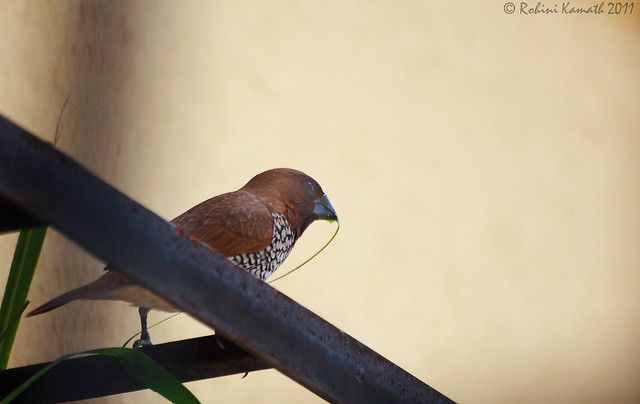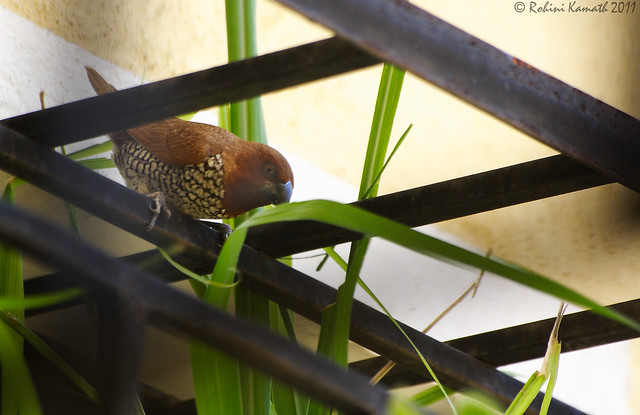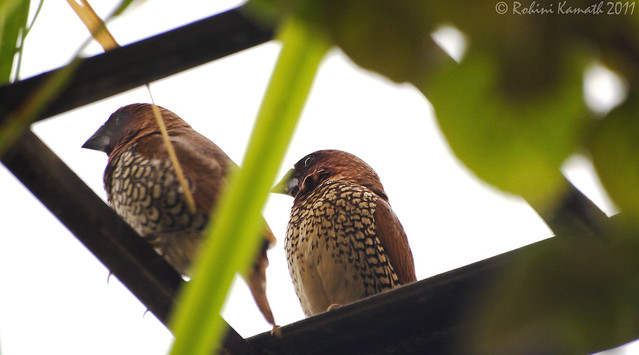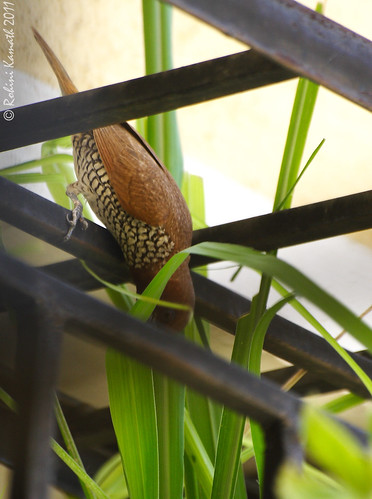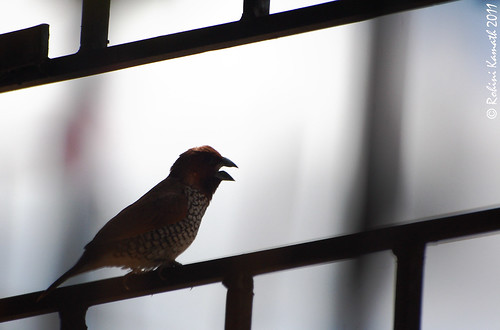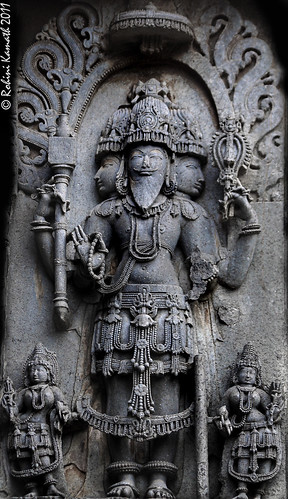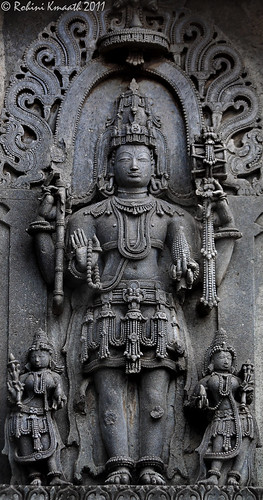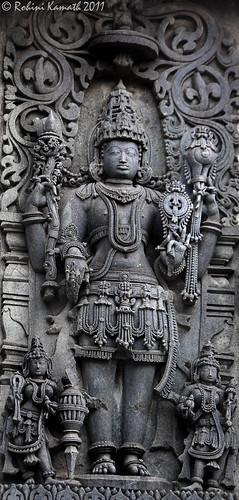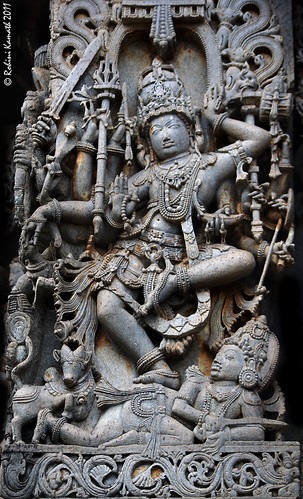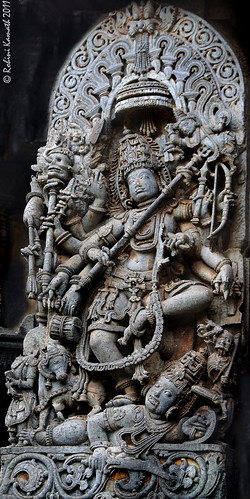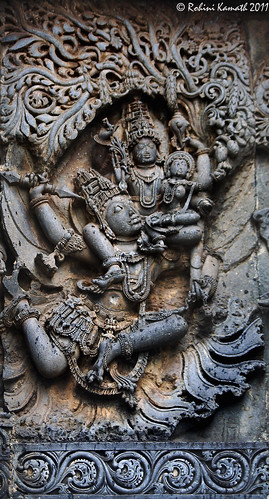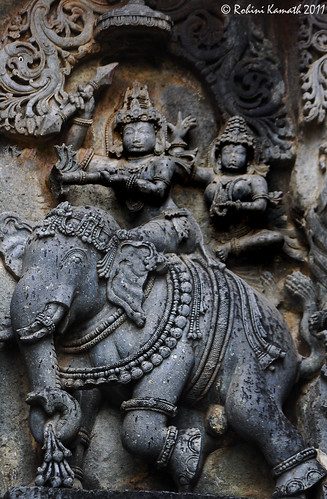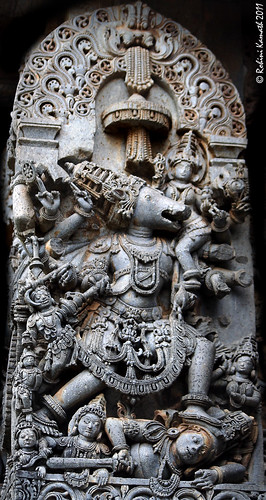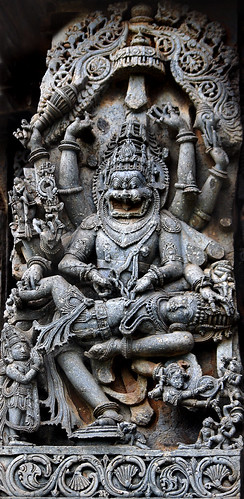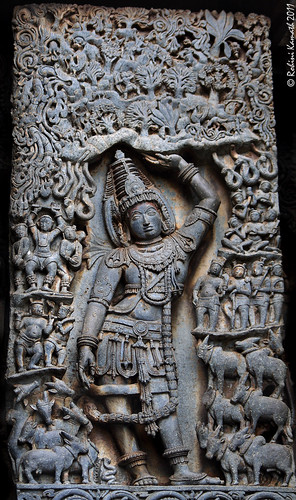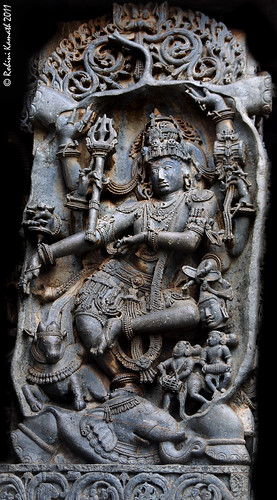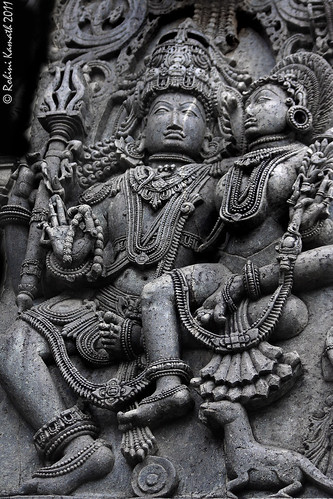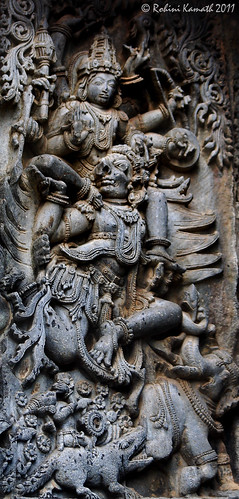Its been a while since my last post and it isn't because of not trying; there's a bunch of partially written drafts covering Bodhgaya, Goa - A RoadTrip, Hampi in various parts, Hogennakal and a few more that have now skipped my memory. The long holidays saw us return from a road trip to Goa, the plan of a similar trip to Pondicherry has been postponed to a different time.
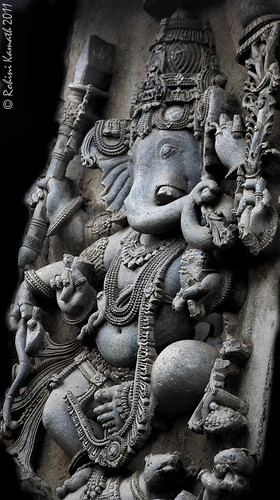
What better way to start than with the remover of obstacles?
This Ganesh Chaturti we thought of doing Halebidu and Belur. What we did not factor in our plan was the monsoon, the sheer size and innumerable carvings of the Halebidu Temple and the sheer size and innumerable pot holes that were generously sprinkled enroute. We'll get to the nittigritties of travel in Karnataka later. First, some background. ( As always I will refrain from providing details easily available from wiki )
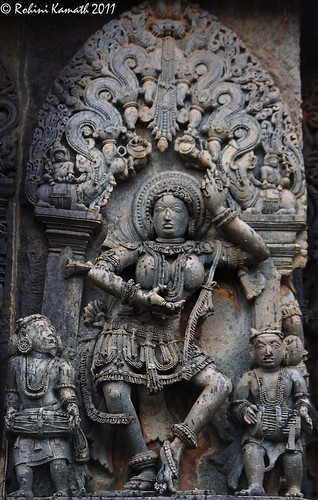
The spots on the sculpture are rain drops | 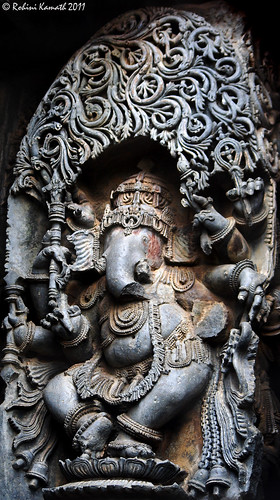
Observe the bells swaying |
Quick History Lesson
Halebidu started life as Dwarasamudra, the Gate to the Sea, named so because of the lake in the city that looked like the sea. The lake is still there and is part of the temple complex. In the early 11th century this city was the capital of the Hoysala Empire. Halebidu means old or ruined city; the name and the ruin came thanks to Alauddin Khilji of the Mughal Sultanate. The city was laid to ruin twice, once in 1311 and then again in 1327.
By 1336, the Sultanate in Delhi had conquered the Pandyas of Madurai, the Kakatiyas of Warangal and the tiny kingdom of Kampili. The Hoysalas were the only remaining Hindu empire who resisted the invading armies. Veera Ballala III, the last king of the Hoysala Empire stood strong against the destroying forces and managed to hold them off until he was killed at the battle of Madurai in 1343.
But before we lose hope, be aware, all was not lost. Veera Ballala had 2 commanders, Harihara (Hakka) and Bukkaraya (Bukka) - do the names sound familiar? Thats because the remaining regions of the erstwhile Hoysala empire merged and formed itself into a kingdom under these able commanders. This new Hindu kingdom resisted the Mughal invasions and would later find fame and fortune as the great Vijayanagara Empire. This empire would give Karnataka the wonders of Hampi, which I hope to cover in satisfactory detail in a following blog.
This set of images depicts the Holy Trinity ( usually represented by Brahma, Vishnu and Shiva (Mahesh) ).
Here, I have placed them as they appeared on the temple wall, which featured Shiva in the middle, since this was after all his temple. Identifying is easy, Brahma has 4 heads ( 3 are visible 4th is behind ), Shiva is identified by the Drum, for Vishnu ( shanka, chakra, mace, padma ).
The Temple
The temple at Halebidu is actually a pair of shrines joined together. The deity is Shiva. The 2 shrines are for Hoysaleshwara ( Shiva given a name after the king ) and Shataleshwara. ( Shiva named after the Queen Shantala ). The King was Vishnuwardhana. Work on the temple began in 1121 AD ( ASI tells us that it was in 1120, funded by 2 merchants Ketamalla and Kesarasetti ).
The merchants must have had very deep pockets indeed because like the Energizer bunny, the sculptors kept on going and going. 190 years later, they were still not done. If you're guessing that either money or patience might have run out, you're wrong, the first invasion had occurred.
( Note: wiki says 87 yrs of work, the guide said 190. If you do the math, 190 matches exactly. Also some parts of the temple do look incomplete, so I would go with the guide on this one )
These two images show Shiva vanquishing baddies and doing the Tandav. Many of the sculptures are quite gory, showing severed heads, dripping blood, which is being lapped up by skeletons, dogs etc. Both these are the quite sober in comparison. Observe the right image, Shiva depicted with 14 arms, the left has only 12. I like how on the right image, the snake has made its way through the eye socket of the skeleton and exited through the ear hole. On the left image, the tail of Nandi the Bull ( the transport of Shiva) is depicted raised in anger as it does its bit, stamping on the villian in question.
What to See, How to see
The outer surface is covered with freizes that contain detailed storylines from Ramayana, Mahabharata and the Puranas. Be aware, to read the story in the right order you need to go clockwise. That's because circum-ambulation ( pradakshina ) is done clockwise in Hinduism. The best parts begin from the Royal entrance. The main "public" entrance has the shoe rack so you will start from there in all probability.
If you want to see Hindu mythology in glorious 3D, this is the place for you. The images fairly leap off the walls. Be warned this movie has gore, violence and explicit content which may not appropriate for younger viewers. ( I would give it a PG rating ). Where is all this you ask? The standard Hoysala building guidelines have 6 levels of decorative lines ( you can see it in the Somnathpura temple ) Here, there are 8. One of the additions is a running line of erotica from the Kamasutra.
This depiction narrates the story of the Parijata Plant ( flowering shrub ). This is an action sequence from the scene of the crime ( our gods were pretty human in their faults ). Vishnu and Satyabhama ( his consort ) are fleeing from the gardens of Indra with a cutting of the plant, their getaway vehicle is Garuda ( the eagle, Vishnu's mount ). Hot on their heels is the mighty Airavat ( 4 tusked white elephant of the God of Gods ) Indra is driving the elephant hard, Sachidevi his wife is barely able to hold on due to the speed. The raised tail of the elephant depicts agitation.
After our tour of the temple with the guide, we began taking the photos; I started with the 70-300 to get the hard to reach ones and closeups. The heavens opened up with a drizzle that lasted 30 min and then finally became a downpour that had us imprisoned inside the temple for a good 30 min. So the photos I have are just the initial images, I hadn't even got to the good parts yet. So I didn't get to take any images with the 18-55, so no landscapes and big picture images.
Dwarapalas
The gatekeepers. The handsome chap on the right seems a tad over adorned for someone who is just a security guard. Important to note is also that the weapons and dressing style seem to be very similar to the god being guarded. Observe the Drum he is carrying.
This seemed interesting to me, so I did a little research which yielded more info than I had hoped. See "All about dwarapalas" at the bottom for the link.
Apparently the grandeur of the gatekeepers is a reflection on the grandeur of the temple and the god.
Dvarapalas of Shiva have names & are:
(i)Nandi and Mahakala (to the East)
(ii) Herambha and Bhringi (to the South)
(iii)Durmukha and Pandura (to the West)
(iv) Sita and Asita (to the North).
The first named in each pair stands to the right of the doorway; and the other is stationed to the left. | 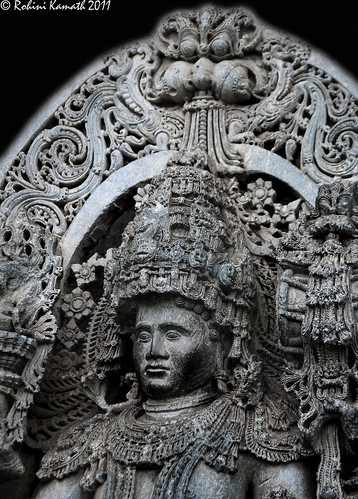 |
From the Dashaavatar, from left to right, ( Vishnu Avatar version 3.0, 4.0 and 8.0 respectively )
Number 3 - Varaha - the boar, rescuing Bhoomi Devi - Mother Earth - from the demon Hiranyaksha
Number 4 - Narasimha - as Prahlad looks on, he extracts the intestines of his dad Hiranyakashipu
The demon names sound similar, coincidence? No, they are brothers. Hiranyakashipu was the elder brother of Hiranyaksha. Mystery solved.
Number 8 - Krishna - 2 armed ( mortal ) Krishna holds up the Govardhan Mountain to protect his village from the torrential downpour. The people are shown sheltering beneath.Infact if you look carefully ( follow flickr link and see large size image ) you can see the detail that has been carved, showing the inhabitants of the mountain, 2 tigers in a cave, 1 monkey, 2 hunters, 1 lizard, 2 birds, a cat catching a mouse.
The details
Wiki mentions that the temple is in dilapidated state, nothing could be further from the truth. The temple is in use and "in worship". And that for you and me means no footwear.
Entry is free, temple is open from Sunrise to Sunset on all days. There is a bored looking priest inside the temple, who will allow you to photograph him. There are guides, and here I must concede they are good. They know their stuff and they give a bill and have a standard charge. Guides speak in Hindi, English and Kannada. There are female guides as well, something I haven't seen anywhere else!
We had Raghu as a guide, and I tested him with lot of questions, being skeptical at first, he passed muster for me, his english was very good as well. Apparently there is a 6 month training provided by ASI to the guides that gives them all the info. Be warned though, later as I wandered taking photos, I found another guide giving a slightly modified version of what had just been explained to me. If you decide to hire the guide, and I suggest you do, ask questions. Do not let them parrot away, take them to the sculptures that they skip and point out areas of doubt. You may be surprised with what you learn. The guide will take 30 min usually, 45min - 1 hr if you ask questions.
The Mayura Hotel from KSTDC is directly opposite the temple. I
recommend you eat there, it is clean and also has toilets. We had the
Veg. thali meals there. Very simple food, but very yummy indeed.
The first image is a depiction of GajasuraMardhana ( the killing of
Gajasura - the elephant demon). Here, Shiva has entered the body of the elephant and is killing the demon from within. Observe the 2 rear legs and tail of the demon at the top. The hollow being the inside of the elephant.
The next is a happy domestic scene, of Shiva and Parvati sitting on his lap, both looking pretty calm. The Mongoose beneath Parvati is her mount in her Calm State. In her Angry phase, she rides a lion.
Other Temples to be visited
Bellavadi - 5 km from Halebidu - we drove there in the rain to check it out for future reference - its smaller and in a tiny street, closely placed with people's houses. Parking will be a problem for the larger cars. But it looked most promising, so I would definitely recommend it. The road is tedious and potholes are many.
Belur - Halebidu and Belur can be done in a single day if you really want to, but I don't recommend it. These are leisurely pursuits, keep in mind that these temples took close to a hundred years to build, the least we can do is give it a few hours time to appreciate the work.
What we will probably do the next time: Stay in Hassan, and make take day trips.
Here we have Saraswati, identified by the beads in her right hand, and the book in the left. They signify spiritual and worldly knowledge, both of which she is the master of. Her mount, the peacock is at her feet. Musicians play as she dances.
The next is an action sequence, showing us in 3D, Gajendra Moksha. ( The liberation of Gajendra - king of elephants ) Here, we see that Makara ( the crocodile - a gandharva ( divine being ) cursed to be a crocodile ) has caught hold of the elephant's leg and is refusing to let go. Gajendra seeks divine intervention to rescue him, and it appears in the form of Vishnu on Garuda. Gajendra offers Vishnu a lotus, raised in his trunk as he prays for help.
Dont Miss These
Due to rain and shortage of time I couldnt get even half of what I wanted to capture. These are a few things you dont want to miss.
Ravana lifting Kailash mountain as he tries to move it to Lanka
Vamana Avatar's encounter with Bali, and his subsequent transformation from Dwarf to Giant.
Mahishasura Mardhini
Vishnu and Lakshmi sitting in the pose of Shiva-Parvati
Churning of the Ocean of Milk.
From the Mahabharat:
Arjuna and Karna Yudha
Chakraview and Abhimanyyu
Arjuna at Draupadi Swayamwar - targeting the eye of the fish
Moral Stories depicted, I was just wowed by how cool this is:
1. Consume Alcohol in moderation. Sage with Alcohol in a pot, bird drinking from it, Snake under the pot. Lesson - drink alcohol in small quantities and you will fly high. In large quantities it is as poisonous as a cobra.
2. External Beauty. Man with a Donkey headed woman. Love the inner qualities of your spouse not the external features.
Route Map
It took us close to 5 hours to get there. With a stop for breakfast and some for nature calls. We left at 6am and were there by 11:30am
View Larger Map
Further Reading:
Wiki - Gothic Art
Wiki - Hoysaleswara_temple
Wiki - Halebidu
Wiki - Hoysala_Empire
Wiki - Veera_Ballala_III
Hoysala Empire from Kamat Potpouri
All about Dwarapalas
Gangaikondacholapuram by R. Nagaswamy
Indian Temples and Iconography
